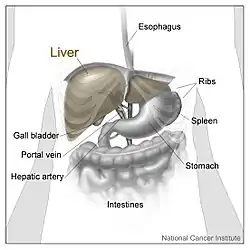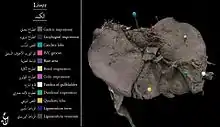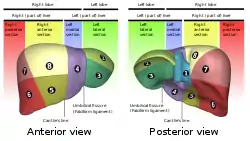Lobes of liver
The human liver is divided grossly into four parts or lobes. The four lobes are the right lobe, the left lobe, the caudate lobe, and the quadrate lobe. Seen from the front – the diaphragmatic surface the liver is divided into two lobes the right lobe, and the left lobe. Viewed from the underside – the visceral surface, the other two smaller lobes the caudate lobe, and the quadrate lobe are also visible.[1] The two smaller lobes, the caudate lobe and the quadrate lobe are known as superficial or accessory lobes and both are located on the underside of the right lobe.[2]
| Lobes of liver | |
|---|---|
 The liver is divided into four lobes. This image shows the large right lobe and a smaller left lobe separated by the falciform ligament. | |
 1: Right lobe of liver 2: Left lobe of liver 3: Quadrate lobe of liver 4: Round ligament of liver 5: Falciform ligament 6: Caudate lobe of liver 7: Inferior vena cava 8: Common bile duct 9: Hepatic artery 10: Portal vein 11: Cystic duct 12: Common hepatic duct 13: Gallbladder | |
| Details | |
| Identifiers | |
| Latin | lobus hepatis |
| Anatomical terminology | |
The falciform ligament, visible on the front of the liver, makes a superficial division of the right and left lobes of the liver. From the underside, the two additional lobes are located on the right lobe.[2] A line can be imagined running from the left of the vena cava and all the way forward to divide the liver and gallbladder into two halves.[3] This line is called Cantlie's line and is used to mark the division between the two lobes.[4]
Other anatomical landmarks exist, such as the ligamentum venosum and the round ligament of the liver (ligamentum teres), which further divide the left side of the liver in two sections. An important anatomical landmark, the porta hepatis, also known as the transverse fissure of the liver, divides this left portion into four segments, which can be numbered starting at the caudate lobe as I in an anticlockwise manner. From this parietal view, seven segments can be seen, because the eighth segment is only visible in the visceral view.[5]

Structure
Segments

The lobes of the liver are further divided into eight liver segments in the Couinaud system. These are also known as hepatic segments that are surgically resectable.[2]
Left lobe
The left lobe is smaller and more flattened than the right. It is situated in the epigastric, and left hypochondriac regions of the abdomen. Its upper surface is slightly convex and is moulded on to the diaphragm; its under surface presents the gastric impression and omental tuberosity.
Right lobe
The right lobe is six times the size of the left lobe. It occupies the right hypochondrium; on its posterior surface by the ligamentum venosum for the cranial (upper) half, and by the ligamentum teres hepatis (Round ligament of liver) for the caudal (under) half. The ligamentum teres hepatis turns around the inferior margin of the liver to come out ventral in the falciform ligament.
The right lobe is functionally separated from the left lobe by the middle hepatic vein. From a functional perspective (one that takes the arterial, portal venous, and systemic venous anatomy into account) the falciform ligament separates the medial and lateral segments of the left hepatic lobe.[6]
The right lobe is of a somewhat quadrilateral form. Its under and posterior surfaces being marked by three fossæ: the fossa for the portal vein, the fossa for the gall-bladder and the fossae for the inferior vena cava. These separate the right lobe in two smaller lobes on its left posterior part: the quadrate lobe and the caudate lobe.
Quadrate lobe
The quadrate lobe is an area of the liver situated on the under surface of the medial segment left lobe (Couinaud segment IVb), bounded in front by the anterior margin of the liver; behind by the porta hepatis; on the right, by the fossa for the gall-bladder; and on the left, by the fossa for the umbilical vein.
It is oblong in shape, its antero-posterior diameter being greater than its transverse.
Caudate lobe
The caudate lobe (posterior hepatic segment I), is situated upon the postero-superior surface of the liver on the right lobe of the liver, opposite the tenth and eleventh thoracic vertebrae.
The caudate lobe of the liver is bounded below, by the porta hepatis; on the right, by the fossa for the inferior vena cava; and, on the left, by the fossa for the ductus venosus and the physiological division of the liver called the ligamentum venosum. It looks backward, being nearly vertical in position; it is longer from above downward than from side to side, and is somewhat concave in the transverse direction. It is situated behind the porta, and separates the fossa for the gall-bladder from the commencement of the fossa for the inferior vena cava. See Adriaan van den Spiegel 1578-1625 Spiegel's lobe.
Budd–Chiari syndrome, caused by occlusion of hepatic venous outflow, can lead to hypertrophy of the caudate lobe due to its own caval anastomosis that allows for continued function of this lobe of the liver.
The caudate lobe is named after the tail-shaped hepatic tissue (cauda; Latin, "tail") papillary process of the liver, which arise from its left side. It also has a caudate process (that is not tail-like shaped) arising from its right side which provides surface continuity between the caudate lobe and the visceral surface of the anatomical right lobe of the liver.[7] The caudate process is a small elevation of the hepatic substance extending obliquely and laterally, from the lower extremity of the caudate lobe to the under surface of the right lobe.
References
This article incorporates text in the public domain from the 20th edition of Gray's Anatomy (1918)
- "Anatomy of the Liver". Liver.co.uk. Retrieved 2015-06-26.
- Moore, K (2018). Clinically oriented anatomy (Eighth ed.). pp. 493–498. ISBN 9781496347213.
- Renz, John F.; Kinkhabwala, Milan (2014). "Surgical Anatomy of the Liver". In Busuttil, Ronald W.; Klintmalm, Göran B. (eds.). Transplantation of the Liver. Elsevier. pp. 23–39. ISBN 978-1-4557-5383-3.
- "Cantlie's line | Radiology Reference Article". Radiopaedia.org. Retrieved 2015-06-26.
- Kuntz, Erwin; Kuntz, Hans-Dieter (2009). "Liver resection". Hepatology: Textbook and Atlas (3rd ed.). Springer. pp. 900–3. ISBN 978-3-540-76839-5.
- Abdel-Misih, Sherif R. Z.; Bloomston, Mark (August 2010). "Liver Anatomy". Surg Clin North Am. Elsevier. 90 (4): 643–53. doi:10.1016/j.suc.2010.04.017. PMC 4038911. PMID 20637938.
- Moore. Clinically Oriented Anatomy - 8th edition. Wolters Kluwer.
External links
- "Anatomy diagram: 12581.000-1". Roche Lexicon - illustrated navigator. Elsevier. Archived from the original on 2012-07-22.
- Anatomy photo:38:12-0201 at the SUNY Downstate Medical Center - "The Visceral Surface of the Liver"
- Anatomy image:7768 at the SUNY Downstate Medical Center
- Anatomy image:8189 at the SUNY Downstate Medical Center
- Cross section image: pembody/body8a—Plastination Laboratory at the Medical University of Vienna
- "Anatomy diagram: 12581.000-1". Roche Lexicon - illustrated navigator. Elsevier. Archived from the original on 2012-07-22.
- Anatomy photo:37:02-0201 at the SUNY Downstate Medical Center - "Abdominal Cavity: Inspection of the Abdominal Viscera in situ"
- Anatomy photo:38:12-0204 at the SUNY Downstate Medical Center - "The Visceral Surface of the Liver"
- Cross section image: pembody/body8a—Plastination Laboratory at the Medical University of Vienna